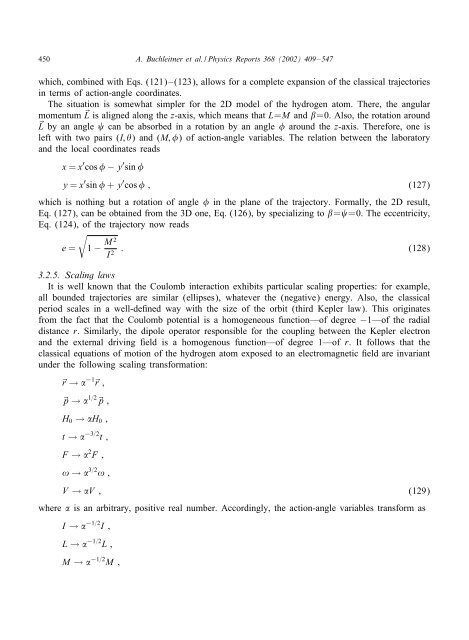Non-dispersive wave packets in periodically driven quantum systems
Non-dispersive wave packets in periodically driven quantum systems
Non-dispersive wave packets in periodically driven quantum systems
Create successful ePaper yourself
Turn your PDF publications into a flip-book with our unique Google optimized e-Paper software.
450 A. Buchleitner et al. / Physics Reports 368 (2002) 409–547<br />
which, comb<strong>in</strong>ed with Eqs. (121)–(123), allows for a complete expansion of the classical trajectories<br />
<strong>in</strong> terms of action-angle coord<strong>in</strong>ates.<br />
The situation is somewhat simpler for the 2D model of the hydrogen atom. There, the angular<br />
momentum ˜L is aligned along the z-axis, which means that L=M and =0. Also, the rotation around<br />
˜L by an angle can be absorbed <strong>in</strong> a rotation by an angle around the z-axis. Therefore, one is<br />
left with two pairs (I; ) and (M; ) of action-angle variables. The relation between the laboratory<br />
and the local coord<strong>in</strong>ates reads<br />
x = x ′ cos − y ′ s<strong>in</strong><br />
y = x ′ s<strong>in</strong> + y ′ cos ; (127)<br />
which is noth<strong>in</strong>g but a rotation of angle <strong>in</strong> the plane of the trajectory. Formally, the 2D result,<br />
Eq. (127), can be obta<strong>in</strong>ed from the 3D one, Eq. (126), by specializ<strong>in</strong>g to<br />
Eq. (124), of the trajectory now reads<br />
= =0. The eccentricity,<br />
<br />
e = 1 −<br />
M 2<br />
I 2 : (128)<br />
3.2.5. Scal<strong>in</strong>g laws<br />
It is well known that the Coulomb <strong>in</strong>teraction exhibits particular scal<strong>in</strong>g properties: for example,<br />
all bounded trajectories are similar (ellipses), whatever the (negative) energy. Also, the classical<br />
period scales <strong>in</strong> a well-de ned way with the size of the orbit (third Kepler law). This orig<strong>in</strong>ates<br />
from the fact that the Coulomb potential is a homogeneous function—of degree −1—of the radial<br />
distance r. Similarly, the dipole operator responsible for the coupl<strong>in</strong>g between the Kepler electron<br />
and the external driv<strong>in</strong>g eld is a homogenous function—of degree 1—of r. It follows that the<br />
classical equations of motion of the hydrogen atom exposed to an electromagnetic eld are <strong>in</strong>variant<br />
under the follow<strong>in</strong>g scal<strong>in</strong>g transformation:<br />
˜r → −1 ˜r;<br />
˜p → 1=2 ˜p;<br />
H0 → H0 ;<br />
t → −3=2 t;<br />
F → 2 F;<br />
! → 3=2 !;<br />
V → V ; (129)<br />
where is an arbitrary, positive real number. Accord<strong>in</strong>gly, the action-angle variables transform as<br />
I → −1=2 I;<br />
L → −1=2 L;<br />
M → −1=2 M;











